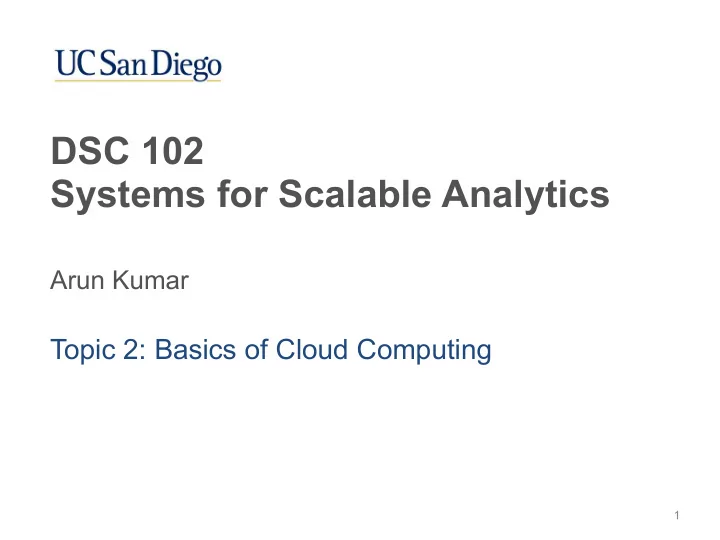

DSC 102 Systems for Scalable Analytics Arun Kumar Topic 2: Basics of Cloud Computing 1
Cloud Computing ❖ Compute, storage, memory, networking, etc. are virtualized and exist on remote servers ; rented by application users ❖ Main pros of cloud vs on-premise clusters: ❖ Manageability : Managing hardware is not user’s problem ❖ Pay-as-you-go : Fine-grained pricing economics based on actual usage (granularity: seconds to years!) ❖ Elasticity : Can dynamically add or reduce capacity based on actual workload’s demand ❖ Infrastructure-as-a-Service (IaaS); Platform-as-a-Service (PaaS); Software-as-a-Service (SaaS) 2
Cloud Computing 3
Examples of AWS Cloud Services ❖ IaaS : ❖ Compute : EC2, ECS, Fargate, Lambda ❖ Storage : S3, EBS, EFS, Glacier ❖ Networking : CloudFront, VPC ❖ PaaS : ❖ Database/Analytics Systems : Aurora, Redshift, Neptune, ElastiCache, DynamoDB, Timestream, EMR, Athena ❖ Blockchain : QLDB; IoT : Greengrass ❖ SaaS : ❖ ML/AI : SageMaker, Elastic Inference, Lex, Polly, Translate, Transcribe, Textract, Rekognition, Ground Truth ❖ Business Apps : Chime, WorkDocs, WorkMail 4
Evolution of Cloud Infrastructure ❖ Data Center : Physical space from which a cloud is operated ❖ 3 generations of data centers/clouds: ❖ Cloud 1.0 (Past) : Networked servers; user rents servers (time-sliced access) needed for data/software ❖ Cloud 2.0 (Current) : “Virtualization” of networked servers; user rents amount of resource capacity; cloud provider has a lot more flexibility on provisioning (multi-tenancy, load balancing, more elasticity, etc.) ❖ Cloud 3.0 (Ongoing Research) : “Serverless” and disaggregated resources all connected to fast networks 5
3 Paradigms of Multi-Node Parallelism Independent Workers Interconnect Contention Contention Interconnect Interconnect Shared-Nothing Shared-Disk Shared-Memory Parallelism Parallelism Parallelism Most parallel RDBMSs (Teradata, Greenplum, Redshift), Hadoop, and Spark use shared-nothing parallelism 6
Revisiting Parallelism in the Cloud Modern networks in data centers have become much faster: 100GbE to even TbE! Interconnect ❖ Decoupling of compute+memory from storage is common in cloud ❖ Hybrids of shared-disk parallelism Shared-Disk + shared-nothing parallelism Parallelism ❖ E.g, store datasets on S3 and read as needed to local EBS 7
Example: AWS Services for PA1 Machine Machine Instance 1 Instance 2 Elastic Compute Cloud (EC2) … Elastic Block Storage (EBS) Internet You AWS-internal Interconnect Simple Storage Service (S3) AWS … Data Center(s) 8
Example: AWS services for ML app. 9 https://docs.aws.amazon.com/sagemaker/latest/dg/how-it-works-training.html
Revisiting Parallelism in the Cloud Interconnect Such bundling means some applications might under-utilize some resources! ❖ Serverless paradigm gaining traction for some applications, e.g., online ML prediction serving on websites ❖ User gives a program (function) to run and specifies CPU and DRAM needed ❖ Cloud provider abstracts away Shared-Nothing resource provisioning entirely Parallelism ❖ Much higher overall resource efficiency; often much cheaper too! ❖ Aka Function-as-a-Service (FaaS) 10
Example: Serverless RDBMS on AWS Simple interactive Remote read of Schema-on-read queries data from S3 Many data formats 11 https://www.xenonstack.com/blog/amazon-athena-quicksight/
Example: Serverless ML app. on AWS 12 https://aws.amazon.com/quickstart/architecture/predictive-data-science-sagemaker-and-data-lake/
Disaggregation: Glimpse into the Future? ❖ Logical next step in serverless direction: full resource disaggregation ! That is, compute, memory, storage, etc. are all network-attached and elastically added/removed Add more memory to load new data during execution Add more CPUs to better Interconnect parallelize new computation Ongoing Research : Fulfill this promise with low latency!
Example: AWS services for IoT app. 14 https://aws.amazon.com/blogs/machine-learning/amazon-sagemaker-neo-helps-detect-objects-and-classify-images-on-edge-devices/
OMG, is all this complexity worth it?! ❖ Ultimately depends on user’s/application’s tradeoffs! :) ❖ On-premise clusters are still common, especially in large enterprises, healthcare, and academia; “hybrid clouds” too ❖ Recall main pros of cloud: manageability, cost, and elasticity ❖ Some “cons” of cloud (vs on-premise): ❖ Complexity of composing cloud APIs and licenses; data scientists must keep relearning; “CloudOps” teams ❖ Cost over time can crossover and make it costlier! ❖ “Lock-in” by cloud vendor ❖ Privacy , security , and governance concerns ❖ Internet disruption or unplanned downtime , e.g., AWS outage in 2015 made Netflix, Tinder, etc. unavailable! :) 15
OMG, is all this complexity worth it?! 16
The State of the Cloud Survey 17 https://www.flexera.com/blog/cloud/2019/02/cloud-computing-trends-2019-state-of-the-cloud-survey/
The State of the Cloud Survey 18 https://www.flexera.com/blog/cloud/2019/02/cloud-computing-trends-2019-state-of-the-cloud-survey/
The State of the Cloud Survey 19 https://www.flexera.com/blog/cloud/2019/02/cloud-computing-trends-2019-state-of-the-cloud-survey/
The State of the Cloud Survey 20 https://www.flexera.com/blog/cloud/2019/02/cloud-computing-trends-2019-state-of-the-cloud-survey/
The State of the Cloud Survey 21 https://www.flexera.com/blog/cloud/2019/02/cloud-computing-trends-2019-state-of-the-cloud-survey/
Recommend
More recommend